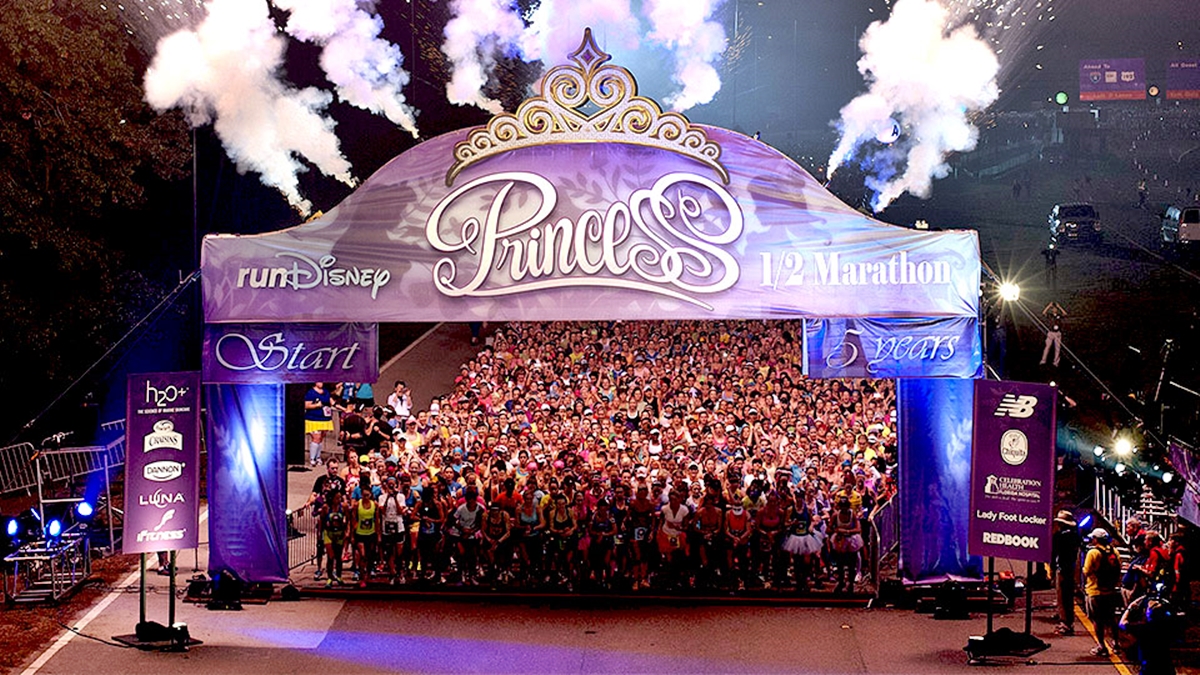Home>Misc>Featured>Training On How To Run A Half Marathon In 6 Months


Featured
Training On How To Run A Half Marathon In 6 Months
Modified: August 21, 2023
Want to conquer a half marathon in just 6 months? Join our featured training program and learn how to run like a pro!
Introduction
Welcome to the exciting world of half marathon training! Whether you’re a seasoned runner looking to push your limits or a newbie taking on a new fitness challenge, training for a half marathon is an incredible journey that can transform your physical and mental capabilities.
Running a half marathon, which is 13.1 miles or 21 kilometers, requires dedication, perseverance, and a well-structured training plan. It’s not a race to be taken lightly, but with the right preparation, anyone – yes, even you – can conquer this distance.
The beauty of training for a half marathon is that it’s not just about the final race day. It’s about the months of progress, the personal growth, and the self-discovery along the way. It’s a chance to push your limits, break through barriers, and become the best version of yourself.
In this comprehensive guide, we will walk you through the process of training for a half marathon in six months. By following the steps outlined in this article, you will have a solid foundation and the necessary tools to help you achieve your goal of crossing that finish line.
First, we will discuss the importance of setting a goal and creating a plan. Setting a clear objective and mapping out your training schedule will provide you with focus and direction throughout your journey. We will also guide you in choosing the right training schedule that aligns with your current fitness level and goals.
Next, we will explore the crucial steps of building a base and increasing your mileage. Gradually increasing your weekly mileage is essential for developing the endurance necessary to complete a half marathon. We will share expert tips on how to safely increase your mileage while minimizing the risk of injury.
Once you have established a solid foundation, we will delve into the realm of speed work and hill training. Incorporating these workouts into your routine will improve your running efficiency, increase your speed, and prepare you for the varied terrain you may encounter during your half marathon.
Injury prevention and stretching are vital components of any training plan. We will outline key strategies to help you stay injury-free and provide a comprehensive stretching routine to optimize your flexibility and reduce the risk of muscle imbalances.
Proper nutrition and hydration are essential for optimal performance. We will offer valuable tips on fueling your body pre, during, and post-run, as well as hydrating effectively to maintain your energy levels throughout your training.
Running a half marathon is not just a physical challenge; it’s a mental one as well. We will explore various mental preparation techniques and motivation strategies to help you stay focused, overcome obstacles, and maintain a positive mindset as you prepare for race day.
The day of the half marathon can be nerve-wracking, but with our tips, you will be equipped to tackle those race day jitters. From pre-race routines to pacing strategies, we will guide you through every step of the process.
Finally, we will conclude with strategies for a successful half marathon. We will discuss how to approach the race, pace yourself, and make any necessary adjustments along the way to ensure that you cross the finish line feeling strong and accomplished.
So, are you ready to embark on this incredible journey? Let’s dive in and start your half marathon training!
Setting a Goal and Creating a Plan
Before lacing up your running shoes and hitting the pavement, it’s essential to set a goal and create a clear plan for your half marathon training. Setting a goal will give you a sense of purpose and motivate you to stay committed throughout the process.
Start by deciding on a realistic finish time or a specific objective you want to accomplish. This could be completing your first half marathon, achieving a personal best, or simply enjoying the experience and crossing the finish line with a smile on your face.
Once you have a goal in mind, it’s time to create a training plan. A well-structured plan will ensure that you progress gradually, avoid injury, and reach your full potential on race day.
Consider your current fitness level, running experience, and the time you have available to devote to training. If you’re new to running or haven’t been active in a while, it’s essential to start slowly and build your endurance over time. Conversely, if you’re an experienced runner, you may need a more challenging plan to push your limits.
Many training plans range from 12 to 16 weeks, but since you have six months to prepare, you have the luxury of starting with a more gradual and conservative approach. This extended time frame allows for additional flexibility and reduces the risk of burnout or overtraining.
Once you’ve determined the duration of your training plan, it’s time to break it down into weekly and monthly milestones. Divide your training into phases, each focusing on specific aspects such as building a base, increasing mileage, and incorporating speed work and hill training.
Schedule your runs and cross-training sessions in a way that works best for you. Find a balance between running, rest days, strength training, and flexibility exercises. It’s crucial to allow your body time to recover and adapt to the physical demands of training.
Remember, flexibility is key when creating your plan. Life happens, and unexpected events may arise, leading to missed workouts or changes in your schedule. Don’t get discouraged if you have to make adjustments. Your training plan is a guide, and it’s important to listen to your body and make modifications as needed.
Additionally, consider incorporating races or fun runs into your training plan as checkpoints along the way. These events can help you gauge your progress, test your race day strategies, and provide a sense of accomplishment throughout your training.
Setting a goal and creating a comprehensive plan will set you up for success and provide you with the motivation and structure needed to complete your half marathon. As you embark on this journey, remember to stay committed, be flexible, and enjoy the process. Your hard work and dedication will pay off as you cross that finish line on race day!
Choosing the Right Training Schedule
When it comes to training for a half marathon, choosing the right training schedule is crucial for your success. The training schedule you select should align with your current fitness level, goals, and available time commitment. Let’s explore some factors to consider when choosing the right training schedule for you.
1. Fitness Level: Take an honest assessment of your current fitness level. If you’re a beginner or have been inactive for a while, look for a training schedule designed for novice runners. These plans typically start with a combination of walking and running, gradually increasing the run intervals over time. If you’re more experienced, you may opt for an intermediate or advanced training schedule that includes higher mileage and more intense workouts.
2. Time Commitment: Consider the amount of time you can dedicate to training each week. Training for a half marathon requires consistent effort, so be realistic about how many days per week you can commit to running and cross-training activities. Some training schedules may have you running four to five days a week, while others may have less frequency but longer runs on specific days.
3. Schedule Flexibility: Evaluate how flexible your schedule is. If you have a busy work schedule or other commitments, look for a training plan that allows for adjustments. For example, some plans may have long runs on Sundays, but if that conflicts with your schedule, find one that allows for these key workouts on Saturdays or other days that work better for you.
4. Gradual Progression: Look for a training schedule that incorporates gradual progression in terms of mileage and intensity. Going from zero to 13.1 miles in a few weeks isn’t advisable and increases the risk of injury. A well-designed training plan will have a structured approach, gradually increasing mileage while allowing for recovery weeks to prevent burnout.
5. Variety and Cross-Training: Consider whether you prefer a training schedule that includes variety in terms of workouts and cross-training activities. Some plans may include interval training, tempo runs, hill repeats, and cross-training options like cycling or swimming. Variety not only keeps your training interesting but also helps improve overall fitness and prevents boredom or burnout.
6. Personalization: Keep in mind that everyone is unique, and what works for one person may not work for another. It’s essential to find a training schedule that you feel comfortable with and can confidently follow. Don’t be afraid to modify a plan to suit your needs, such as adjusting rest days or swapping workouts to fit your preferences and lifestyle.
7. Professional Guidance: If you’re unsure about choosing a training schedule, consider seeking guidance from a running coach or a qualified professional. They can help assess your individual needs and develop a personalized training plan that aligns with your goals and abilities.
Remember, your training schedule is not set in stone. It’s a guide to help you stay on track and progress towards your goal. Listen to your body, be flexible, and make adjustments as needed. The most important aspect of any training plan is consistency and a gradual build-up of mileage. With the right training schedule in hand, you’ll be well-prepared to conquer your half marathon goal on race day!
Building a Base and Increasing Mileage
Building a solid base and gradually increasing your mileage is a critical step in your half marathon training journey. It lays the foundation for your endurance and prepares your body for the longer distance. Here are key considerations to keep in mind as you build your base and increase your mileage.
1. Start Slowly: If you’re new to running or haven’t been active for a while, it’s crucial to start with a conservative approach. Begin with a combination of running and walking intervals, gradually increasing the time spent running. This gradual progression allows your body to adapt to the demands of running and reduces the risk of injury.
2. Be Consistent: Consistency is key when building a base. Aim to run three to four times a week, with rest days in between to allow for recovery and adaptation. As you steadily build your endurance, consider adding cross-training workouts on your rest days to enhance overall fitness and prevent overuse injuries.
3. Increase Mileage Gradually: It’s important to increase your mileage gradually to avoid overtraining and injury. Experts suggest increasing your weekly mileage by no more than 10% each week. This conservative approach gives your body time to adapt and minimizes the risk of stress fractures, muscle strains, and other common running injuries.
4. Long Runs: Incorporate weekly long runs into your training routine. These runs should be done at a comfortable pace, focusing on time spent on your feet rather than speed. Start with a distance that is challenging but manageable, and increase the distance progressively each week. These long runs are essential for building endurance and mental strength.
5. Recovery Runs: In addition to long runs, include shorter recovery runs in your training program. These runs are done at an easy pace and help promote recovery and improve aerobic fitness without placing excessive stress on your body. Aim for at least one or two recovery runs each week.
6. Rest and Recovery: Remember to prioritize rest and recovery. Your body needs time to repair and rebuild after each run. Include rest days in your training schedule to allow muscles, tendons, and ligaments to recover and grow stronger. Additionally, incorporate activities such as stretching, foam rolling, and adequate sleep to aid in the recovery process.
7. Listen to Your Body: Pay close attention to how your body feels throughout your training. If you experience excessive fatigue, persistent pain, or signs of overtraining, be willing to modify your training plan accordingly. It’s better to take a step back and rest than to push through and risk injury.
8. Stay Hydrated and Fuel Properly: As your mileage increases, it becomes even more important to hydrate properly and fuel your body with the right nutrients. Ensure you’re drinking enough water throughout the day and consider incorporating electrolyte-rich drinks for longer runs. Prioritize a well-balanced diet that includes carbohydrates, protein, and healthy fats to support your training and aid in recovery.
By building a solid base and gradually increasing your mileage, you will develop the endurance necessary to complete a half marathon. Remember, the key is consistency and patience. Embrace the process, trust in your training, and keep pushing forward. Soon enough, you’ll be ready to take on the challenge of 13.1 miles!
Incorporating Speed Work and Hill Training
As you progress in your half marathon training, incorporating speed work and hill training into your routine becomes crucial. These workouts help improve your running efficiency, increase your speed, and prepare you for the varied terrain you may encounter during your half marathon. Here are some key considerations for incorporating speed work and hill training into your training plan.
1. Speed Work: Speed work involves structured workouts designed to improve your running pace. It typically includes interval training, tempo runs, and fartlek workouts. Interval training involves running at a faster pace for a specific distance or time, followed by a recovery period. Tempo runs involve running at a challenging but sustainable pace for a longer distance. Fartlek workouts are unstructured and involve alternating between easy running and faster efforts throughout your run. Incorporate one or two speed work sessions into your weekly training plan, allowing for adequate rest and recovery between workouts.
2. Hill Training: Hill training is essential for building leg strength and improving your ability to tackle inclines during your half marathon. Find a route with varying degrees of incline, whether it’s hills in your neighborhood or a nearby park. Incorporate hill repeats into your training once a week, where you run up a hill at an effort level that challenges you, followed by a recovery jog downhill. As you progress, increase the number of hill repeats and the duration of the effort, gradually building strength and endurance.
3. Gradual Progression: When incorporating speed work and hill training into your plan, it’s important to progress gradually. Start with shorter intervals and easier efforts, gradually increasing the intensity and duration over time. This gradual progression allows your body to adapt to the increased demands and reduces the risk of injury.
4. Warm-up and Cool-down: Before engaging in speed work or hill training, ensure you properly warm-up with some dynamic exercises, gentle jogging, or strides to activate your muscles and increase your heart rate. After the workout, cool down with an easy jog and some static stretches to help your muscles recover and reduce post-workout soreness.
5. Form and Technique: Pay attention to your running form and technique during speed work and hill training. Focus on maintaining an upright posture, engaging your core, and driving your arms forward and backward. When running uphill, shorten your stride and maintain a consistent effort level rather than trying to maintain your usual pace. Practicing good form will help improve your efficiency and reduce the risk of injury.
6. Rest and Recovery: Speed work and hill training can be physically demanding, so be sure to allow for adequate rest and recovery between workouts. Your body needs time to adapt and repair itself, so incorporate rest days and easier runs in between your challenging workouts. Listen to your body, and don’t hesitate to take an extra rest day or modify your training if you’re feeling fatigued or experiencing any pain.
By incorporating speed work and hill training into your half marathon training regimen, you’ll improve your overall fitness, increase your speed, and gain the strength necessary to tackle any hills you may encounter. Remember to progress gradually, prioritize proper form, and allow for adequate rest and recovery. With consistent effort and dedication, you’ll be well-prepared to conquer the challenges of your half marathon race!
Injury Prevention and Stretching
When training for a half marathon, injury prevention should be a top priority. By incorporating proper stretching techniques and implementing injury prevention strategies into your routine, you can minimize the risk of common running injuries and ensure that you stay healthy throughout your training. Here are some essential tips to help you prevent injuries and maintain optimal performance.
1. Warm-Up and Cool-Down: Prior to each run, it’s crucial to warm up your muscles and prepare them for the workout ahead. Start with a few minutes of light jogging or brisk walking to increase your heart rate and circulation. Follow this with dynamic stretches, such as leg swings, walking lunges, or hip circles, to engage your muscles and improve mobility. After your run, take the time to cool down with a slow jog or walk, followed by some static stretches to help promote muscle recovery and flexibility.
2. Stretching: Incorporating a regular stretching routine can help improve flexibility, prevent muscle imbalances, and reduce the risk of injury. Focus on stretching the major muscle groups used in running, including your calves, hamstrings, quadriceps, hip flexors, and glutes. Hold each stretch for 20 to 30 seconds and perform them after your warm-up or at the end of your workout when your muscles are warm. Remember to breathe deeply and avoid bouncing or jerking movements during your stretches.
3. Strength Training: Including strength training exercises in your routine can help improve your overall muscular strength and stability, reducing the risk of injury. Focus on exercises that target your core, hips, glutes, and lower body, as these are key areas used in running. Incorporate exercises such as squats, lunges, planks, bridges, and clamshells. Aim to strength train two to three times a week, allowing for proper recovery between sessions.
4. Cross-Training: Engaging in cross-training activities can help maintain cardiovascular fitness without putting excessive strain on your running muscles. Consider activities such as cycling, swimming, or yoga to provide a break from repetitive impact and develop overall fitness. These activities can also help address muscle imbalances and improve flexibility.
5. Listen to Your Body: Pay attention to any signs of pain, discomfort, or unusual fatigue during your training. If you experience persistent pain, reduce your mileage or intensity and give your body time to recover. Ignoring pain can lead to more severe injuries. If symptoms persist, consider consulting a healthcare professional for a proper evaluation and guidance.
6. Rest and Recovery: Rest and recovery are integral parts of injury prevention. Give your body adequate time to recover between workouts by incorporating rest days into your training plan. These rest days allow your muscles, tendons, and ligaments to repair and rebuild, reducing the risk of overuse injuries. Additionally, prioritize sleep, as it plays a crucial role in the recovery process and overall performance.
7. Proper Footwear: Wearing appropriate running shoes that provide proper support and cushioning is essential for injury prevention. Visit a specialized running store to get fitted for a pair of shoes that suit your running style and foot type. Replace your shoes regularly, as worn-out shoes can contribute to biomechanical issues and increase the risk of injuries.
By incorporating these injury prevention strategies into your training program, you’ll minimize the likelihood of running-related injuries and ensure that you can perform at your best throughout your half marathon training. Remember, taking the time to care for your body and prevent injuries will allow you to enjoy the journey of training and make it safely to the start line of your half marathon race.
Nutrition and Hydration Tips
Proper nutrition and hydration play a vital role in optimizing performance and supporting your body’s needs during half marathon training. By fueling your body with the right nutrients and maintaining proper hydration, you can enhance your energy levels, improve recovery, and perform at your best. Here are some essential nutrition and hydration tips to keep in mind throughout your training.
1. Balanced Diet: Focus on consuming a well-balanced diet that includes a variety of nutrient-dense foods. Aim to incorporate a mix of carbohydrates, protein, and healthy fats. Carbohydrates provide the primary fuel source for endurance activities, so prioritize whole grains, fruits, vegetables, and legumes. Protein is important for muscle repair and recovery, so include lean sources such as chicken, fish, tofu, and beans. Healthy fats from sources like avocados, nuts, and olive oil provide sustained energy and support overall health.
2. Pre-Run Fueling: Before a run, aim to consume a light meal or snack that provides a combination of carbohydrates and protein. This will give you the necessary energy while facilitating muscle repair and maintenance. Opt for easily digestible foods like a banana with nut butter, a yogurt parfait with granola, or a small bowl of oatmeal topped with berries and nuts.
3. Proper Hydration: Hydration is crucial for maintaining optimal performance and preventing dehydration. Start by ensuring that you are properly hydrated throughout the day by drinking water consistently. During your runs, aim to consume water or a sports drink to replenish fluids and electrolytes lost through sweat. Listen to your body and drink when you feel thirsty, and remember to adjust your fluid intake based on weather conditions and the intensity of your workouts.
4. Fueling During Long Runs: For long runs lasting longer than an hour, it’s important to consume additional fuel to maintain energy levels. Experiment with different options like energy gels, sports drinks, or small snacks such as energy bars or bananas. Practice your fueling strategy during training to determine what works best for you and does not upset your stomach.
5. Recovery Nutrition: After a run, prioritize your recovery nutrition to aid in muscle repair and replenish glycogen stores. Aim to consume a snack or meal that includes both carbohydrates and protein within 30 to 60 minutes after your run. This could be a smoothie with fruit and protein powder, Greek yogurt with granola and berries, or a lean protein source with roasted vegetables and quinoa.
6. Individualized Approach: Remember that nutrition and hydration needs can vary among individuals. What works for one person may not work for another. Listen to your body, pay attention to how different foods and fluids make you feel, and make adjustments accordingly. Consider consulting with a registered dietitian who specializes in sports nutrition for personalized guidance.
7. Timing: Pay attention to the timing of your meals and snacks. Aim to consume a balanced meal or snack containing carbohydrates and protein about 2-3 hours before a run to allow for proper digestion. For smaller snacks, eat them about 30 minutes to an hour before your run. Post-run, aim to consume your recovery meal or snack within the recommended 30 to 60-minute window.
By following these nutrition and hydration tips, you’ll provide your body with the fuel and support it needs to excel in your half marathon training. Remember that each individual is unique, so it’s essential to find what works best for your body and makes you feel your best. With a well-nourished body and proper hydration, you’ll be well-prepared to tackle the miles ahead and cross that half marathon finish line with flying colors!
Mental Preparation and Motivation Techniques
While physical training is important for a successful half marathon, mental preparation plays a crucial role as well. Having a strong mindset and motivation can help you push through challenging moments, overcome self-doubt, and stay focused during your training and on race day. Here are some mental preparation and motivation techniques to incorporate into your half marathon journey.
1. Set Clear Goals: Start by setting clear and realistic goals for yourself. Having a specific target can provide you with a sense of direction and motivation. Your goals may include finishing the race within a certain time, completing your first half marathon, or simply enjoying the experience. Write down your goals and revisit them regularly to remind yourself of what you’re working towards.
2. Visualize Success: Visualize yourself crossing the finish line strong and feeling accomplished. Create a mental image of yourself completing the half marathon, overcoming any obstacles along the way. Visualizing success can help boost your confidence and motivation, and make your goals feel more attainable.
3. Positive Self-Talk: Pay attention to your inner dialogue and replace negative thoughts with positive ones. Use positive affirmations and encouraging statements to boost your confidence and keep your spirits high. Instead of saying “I can’t do this,” replace it with “I am strong and capable. I can do this!” Give yourself credit for every step you take towards your goal.
4. Break it Down: The half marathon distance can feel overwhelming at times. Break it down into smaller, manageable chunks to make it feel more attainable. Focus on getting through one mile at a time or reaching different landmarks along your training runs. Celebrate each milestone, and use them as stepping stones to reach your ultimate goal.
5. Find Your Motivation: Discover what motivates you and use it as fuel during your training. This could be anything from running for a charitable cause, dedicating your training to someone special, or the desire to challenge yourself. Find your why and remind yourself of it when the training becomes tough.
6. Surround Yourself with Support: Engage with a supportive community of fellow runners, friends, or family who can cheer you on during your training. Share your progress, challenges, and achievements with them. Their encouragement and positive energy can greatly boost your motivation and help you stay committed.
7. Practice Mindfulness and Stress Relief: Incorporate mindfulness techniques and stress relief practices into your daily routine. These may include meditation, deep breathing exercises, yoga, or journaling. These practices can help reduce anxiety, improve focus, and keep you mentally grounded and present throughout your training.
8. Embrace the Journey: Remember that the half marathon training journey is just as important as the race itself. Embrace the process, enjoy each run, and take pride in your progress. Take time to appreciate the improvements and personal growth you experience along the way. By doing so, you’ll develop a greater sense of satisfaction and ensure a more enjoyable overall experience.
9. Accept and Embrace Challenges: Running a half marathon is not always easy, and there will be setbacks and challenges along the way. Embrace these moments as opportunities for growth and learning. Overcoming obstacles will make you stronger and more resilient. Believe in yourself and your ability to overcome any challenge that comes your way.
Remember, half marathon training is not just a physical endeavor; it’s a mental one as well. With the right mental preparation and motivation techniques, you’ll be equipped to tackle any obstacle and achieve your goals. Stay focused, believe in yourself, and enjoy the journey as you prepare for your half marathon race!
Dealing with Race Day Jitters
Race day is an exciting and nerve-wracking experience for many runners, especially if it’s your first half marathon. It’s natural to feel a mix of anticipation and nervousness as you prepare to tackle the challenge ahead. However, with proper preparation and a positive mindset, you can manage these race day jitters and perform at your best. Here are some tips to help you deal with race day jitters:
1. Stick to Your Routine: Stick to your regular routine on race day as much as possible. This includes maintaining your usual sleep schedule, eating familiar foods, and performing your typical warm-up routine. Following your routine will help you feel comfortable and confident, reducing anxiety.
2. Arrive Early: Aim to arrive at the race venue early. This allows you sufficient time for parking, checking in, using the restroom, and warming up. Being organized and prepared will help reduce last-minute stress and give you a chance to familiarize yourself with the surroundings.
3. Visualize Success: Use visualization techniques to imagine yourself successfully completing the race. Picture yourself running strong, crossing the finish line, and feeling a sense of accomplishment. Visualizing success can boost your confidence and ease race day jitters.
4. Focus on the Process: Instead of fixating solely on the end result, focus on the process of running the race. Pay attention to your breathing, your form, and the subtle movements of your body. By staying present in the moment, you can calm your nerves and perform at your best.
5. Break the Race into Sections: Breaking the race into smaller sections can make it feel more manageable. Focus on running from one mile marker to the next or reaching specific landmarks along the course. By focusing on smaller milestones, the overall distance can feel less overwhelming.
6. Find a Supportive Group: Surround yourself with a supportive group of fellow runners or family and friends who can cheer you on during the race. Their enthusiasm and encouragement can help calm your nerves and give you an extra boost of motivation.
7. Use Positive Self-Talk: Replace negative thoughts with positive affirmations. Remind yourself of your training, your dedication, and your ability to overcome challenges. Use phrases such as “I am prepared,” “I am strong,” and “I can do this!” to boost your confidence and combat race day jitters.
8. Embrace the Excitement: Instead of viewing your pre-race jitters as a sign of anxiety, reframe it as excitement. Embrace the energy and anticipation that comes with race day. Embracing the excitement can help shift your perspective and turn nervousness into positive energy.
9. Trust Your Training: Have confidence in the training you’ve put in leading up to race day. Trust that you have prepared yourself physically and mentally. Remind yourself that you are ready for the challenge and that you have done everything you can to set yourself up for success.
Remember that it’s normal to feel some nervousness on race day. It shows that you care about your performance. Use these strategies to manage your race day jitters and channel your energy into positive focus. Trust in your preparation, believe in yourself, and most importantly, enjoy the experience as you cross the finish line of your half marathon!
Strategies for a Successful Half Marathon
As race day approaches, it’s important to have a plan in place to ensure a successful half marathon experience. The following strategies will help you maximize your performance, overcome challenges, and make the most of your race day:
1. Pace Yourself: Start the race at a comfortable pace, gradually building up as you progress. Avoid the temptation to start too fast and burn out early in the race. Maintain a pace that you have practiced during your training runs and find a rhythm that allows you to conserve energy for the later miles.
2. Hydrate and Fuel: Stay hydrated throughout the race by consuming fluids at water stations along the course. Practice your fueling strategy during training to determine what works best for you and avoid trying anything new on race day. Carry energy gels or other preferred snacks if necessary.
3. Focus on Form: Pay attention to your running form during the race. Maintain good posture, engage your core muscles, and take steady, relaxed strides. Keeping a consistent form will help you run more efficiently and prevent unnecessary fatigue.
4. Break the Distance: Mentally break the race distance into manageable sections or landmarks. Focus on reaching each mile marker or imagining running from one landmark to another. This approach helps you maintain motivation and break the race into smaller, more achievable goals.
5. Use the Crowd’s Energy: Feed off the energy of the crowd along the course. Allow their cheers, signs, and encouragement to motivate you when your energy starts to dip. Engage with spectators and acknowledge their support to boost your spirits along the way.
6. Stay Positive: Maintain a positive mindset throughout the race. Use positive self-talk and affirmations to overcome negative thoughts. Focus on your training, remind yourself of the hard work you have put in, and embrace the experience with gratitude and determination.
7. Embrace Discomfort: Recognize that running a half marathon will involve some discomfort. Embrace the challenge and push through any moments of pain or fatigue. Visualize the finish line and draw on your mental and physical strength to keep going.
8. Run Your Own Race: Avoid getting caught up in comparing yourself to others during the race. Focus on your own progress and goals, rather than trying to keep pace with faster runners. Trust your training and stick to your race plan, regardless of what others around you are doing.
9. Enjoy the Experience: Remember to savor the experience and enjoy the journey. Look around and appreciate the scenery, the support from the crowd, and the camaraderie with fellow runners. Smile, celebrate your accomplishments, and soak in the sense of achievement as you cross the finish line.
10. Reflect and Learn: After the race, take time to reflect on your performance. Identify what worked well and areas that could be improved. Use this feedback to enhance your future training and race strategies. Every race is a learning opportunity, and each experience will make you a stronger runner.
By implementing these strategies, you’ll set yourself up for a successful half marathon. Trust your preparation, maintain a positive mindset, and enjoy the journey as you conquer the distance and cross that finish line. Remember, the half marathon is not just a race; it’s a testament to your dedication, determination, and ability to achieve your goals.
Conclusion
Congratulations! You have learned about the essential steps and strategies involved in training for a half marathon. From setting goals and creating a plan to incorporating speed work and hill training, you now have the tools and knowledge to embark on this challenging journey.
Remember, half marathon training requires commitment, dedication, and perseverance. It’s a test of both physical endurance and mental fortitude. As you progress through your training, it’s important to listen to your body, take rest days when needed, and adapt your training plan as necessary.
Incorporating proper nutrition, hydration, injury prevention, and stretching techniques will support your overall well-being and help you perform at your best. Stay motivated by finding your why, surrounding yourself with a supportive community, and implementing mental preparation techniques to overcome race day jitters and maintain a positive mindset.
On race day, remember to pace yourself, stay hydrated, and most importantly, enjoy the experience. Embrace the challenges along the way and know that every step taken is a testament to your strength and determination.
As you cross the finish line of your half marathon, whether it’s your first or a new personal best, take pride in your accomplishment. Reflect on the progress you’ve made, the obstacles you’ve overcome, and the personal growth you’ve achieved throughout your training journey.
Now, armed with knowledge, motivation, and a well-structured plan, you are ready to conquer the half marathon distance. Trust in yourself, embrace the process, and have confidence that you possess the ability to achieve your goals. Lace up your shoes, hit the pavement, and enjoy the unforgettable experience of running a half marathon!









